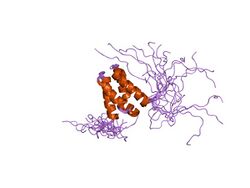Biology:MED26
Mediator of RNA polymerase II transcription subunit 26 is an enzyme that in humans is encoded by the MED26 gene.[1][2] It forms part of the Mediator complex.
The activation of gene transcription is a multistep process that is triggered by factors that recognize transcriptional enhancer sites in DNA. These factors work with co-activators to direct transcriptional initiation by the RNA polymerase II apparatus. The protein encoded by this gene is a subunit of the CRSP (cofactor required for SP1 activation) complex, which, along with TFIID, is required for efficient activation by SP1. This protein is also a component of other multisubunit complexes e.g. thyroid hormone receptor-(TR-) associated proteins which interact with TR and facilitate TR function on DNA templates in conjunction with initiation factors and cofactors.[2]
Activity
MED26 is a transcription elongation factor that increases the overall transcription rate of RNA polymerase II by reactivating transcription elongation complexes that have arrested transcription. It does this through recruiting ELL/EAF- and P-TEFb- containing complexes to promoters via a direct interaction with the N-terminal domain (NTD). The MED26 NTD also binds TFIID, and TFIID and elongation complexes interact with MED26 through overlapping binding sites.[3] MED26 NTD may function as a molecular switch contributing to the transition of Pol II into productive elongation.
The three structural domains of TFIIS are conserved from yeast to human. The 80 or so N-terminal residues form a protein interaction domain containing a conserved motif, which has been called the LW motif because of the invariant leucine and tryptophan residues it contains. Although the N-terminal domain is not needed for transcriptional activity, a similar sequence has been identified in other transcription factors and proteins that are predominantly nuclear localized.[4][5][6] Specific examples are listed below:
- MED26 (also known as CRSP70 and ARC70), a subunit of the Mediator complex, which is required for the activity of the enhancer-binding protein Sp1.
- Elongin A, a subunit of a transcription elongation factor previously known as SIII. It increases the rate of transcription by suppressing transient pausing of the elongation complex.
- PPP1R10, a nuclear regulatory subunit of protein phosphatase 1 that was previously known as p99, FB19 or PNUTS.
- PIBP, a small hypothetical protein that could be a phosphoinositide binding protein.
- IWS1, which is thought to function in both transcription initiation and elongation.[7]
- TFIIS, which rescues RNA polymerase II from backtracked pause states.
The N-terminal domain of MED26 is a protein fold known as a TFIIS N-terminal domain (or TND).[4] It is a compact five-helix bundle. The hydrophobic core residues of helices 2, 3, and 4 are well conserved among TFIIS domains, although helix 1 is less conserved.[6]
Interactions
MED26 has been shown to interact with MED8,[8] Cyclin-dependent kinase 8,[8] POLR2A,[8] MED12[8] and MED28.[8] It also acts synergistically to mediate the interaction between REST (a Kruppel-type zinc finger transcription factor that binds to a 21-bp RE1 silencing element present in over 900 human genes) and Mediator.[9]
References
- ↑ "The transcriptional cofactor complex CRSP is required for activity of the enhancer-binding protein Sp1". Nature 397 (6718): 446–450. February 1999. doi:10.1038/17141. PMID 9989412. Bibcode: 1999Natur.397..446R.
- ↑ Jump up to: 2.0 2.1 "Entrez Gene: CRSP7 cofactor required for Sp1 transcriptional activation, subunit 7, 70kDa". https://www.ncbi.nlm.nih.gov/sites/entrez?Db=gene&Cmd=ShowDetailView&TermToSearch=9441.
- ↑ "Human mediator subunit MED26 functions as a docking site for transcription elongation factors". Cell 146 (1): 92–104. July 2011. doi:10.1016/j.cell.2011.06.005. PMID 21729782.
- ↑ Jump up to: 4.0 4.1 "The TFIIS N-terminal domain (TND): a transcription assembly module at the interface of order and disorder". Biochemical Society Transactions 51 (1): 125–135. January 2023. doi:10.1042/BST20220342. PMID 36651856.
- ↑ "Structure of a conserved domain common to the transcription factors TFIIS, elongin A, and CRSP70". The Journal of Biological Chemistry 275 (40): 31266–31268. October 2000. doi:10.1074/jbc.M002595200. PMID 10811649.
- ↑ Jump up to: 6.0 6.1 "A sequence motif conserved in diverse nuclear proteins identifies a protein interaction domain utilised for nuclear targeting by human TFIIS". Nucleic Acids Research 34 (8): 2219–2229. 2006. doi:10.1093/nar/gkl239. PMID 16648364.
- ↑ "A ubiquitous disordered protein interaction module orchestrates transcription elongation". Science 374 (6571): 1113–1121. November 2021. doi:10.1126/science.abe2913. PMID 34822292. Bibcode: 2021Sci...374.1113C.
- ↑ Jump up to: 8.0 8.1 8.2 8.3 8.4 "A set of consensus mammalian mediator subunits identified by multidimensional protein identification technology". Molecular Cell 14 (5): 685–691. June 2004. doi:10.1016/j.molcel.2004.05.006. PMID 15175163.
- ↑ "MED19 and MED26 are synergistic functional targets of the RE1 silencing transcription factor in epigenetic silencing of neuronal gene expression". The Journal of Biological Chemistry 284 (5): 2648–2656. January 2009. doi:10.1074/jbc.M806514200. PMID 19049968.
Further reading
- "Composite co-activator ARC mediates chromatin-directed transcriptional activation". Nature 398 (6730): 828–832. April 1999. doi:10.1038/19789. PMID 10235267. Bibcode: 1999Natur.398..828N.
- "Structure of a conserved domain common to the transcription factors TFIIS, elongin A, and CRSP70". The Journal of Biological Chemistry 275 (40): 31266–31268. October 2000. doi:10.1074/jbc.M002595200. PMID 10811649.
- "Human CRSP interacts with RNA polymerase II CTD and adopts a specific CTD-bound conformation". Genes & Development 16 (11): 1339–1344. June 2002. doi:10.1101/gad.987602. PMID 12050112.
- "A mammalian homolog of Drosophila melanogaster transcriptional coactivator intersex is a subunit of the mammalian Mediator complex". The Journal of Biological Chemistry 278 (50): 49671–49674. December 2003. doi:10.1074/jbc.C300444200. PMID 14576168.
- "A mammalian mediator subunit that shares properties with Saccharomyces cerevisiae mediator subunit Cse2". The Journal of Biological Chemistry 279 (7): 5846–5851. February 2004. doi:10.1074/jbc.M312523200. PMID 14638676.
- "Ras induces mediator complex exchange on C/EBP beta". Molecular Cell 13 (2): 241–250. January 2004. doi:10.1016/S1097-2765(03)00521-5. PMID 14759369.
- "A set of consensus mammalian mediator subunits identified by multidimensional protein identification technology". Molecular Cell 14 (5): 685–691. June 2004. doi:10.1016/j.molcel.2004.05.006. PMID 15175163.
- "MED1/TRAP220 exists predominantly in a TRAP/ Mediator subpopulation enriched in RNA polymerase II and is required for ER-mediated transcription". Molecular Cell 19 (1): 89–100. July 2005. doi:10.1016/j.molcel.2005.05.015. PMID 15989967.
- "Global, in vivo, and site-specific phosphorylation dynamics in signaling networks". Cell 127 (3): 635–648. November 2006. doi:10.1016/j.cell.2006.09.026. PMID 17081983.
 |



